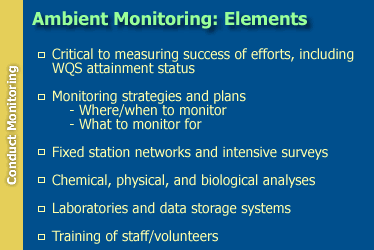

Decisions about what, where, and when to monitor are most important, and the answers to these questions can vary depending on the purpose of the monitoring program.
For example, if the program is supposed to measure the
effectiveness of the CWA's regulatory program dealing with "point sources,"
then monitoring should generally take place just above and just below the discharge
pipes coming from such sources. In addition, it would usually make most sense
to analyze for pollutants that are covered in the source's permit. On the other
hand, if the aim is to get an overall picture of water quality in a state (e.g.,
what percentage of waters are meeting WQS), then a statistically chosen random
set of sampling locations would usually be best. Moreover, the types of pollutants
to be tested for would need to be broader than just those known to be coming
from a particular type of discharger. Currently, state ambient
monitoring programs tend to be focused on waters that the state has declared
impaired or suspects is polluted.
The EPA Monitoring and Assessing Water Quality home page